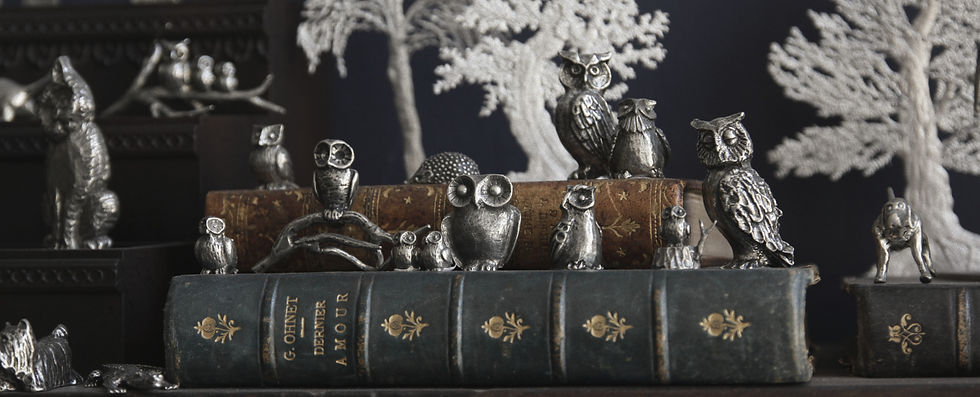
THE ART OF PEWTER
What is Tin?
Tin, a semi-precious, malleable and silver-colored metal, has an ancient history dating back to Antiquity. It was used to make jewelry and decorative items in Egypt, Mesopotamia and even Gaul, where the tinning technique was invented. It also plays a crucial role in the making of bronze, an alloy of copper and tin used to create tools, weapons and ornaments. Its use developed in the Middle Ages in Europe, where, sometimes mixed with other materials such as lead, it was used in the manufacture of plates, dishes and kitchen utensils, as well as in the creation of liturgical objects, in addition to being used in the production of coins.
During modern times its use has expanded to new areas such as tableware, cutlery and containers for storing food and drinks. With the industrial revolution, tin became essential in industry for the manufacture of cans, electrical cables and anti-corrosion coatings. Nowadays, it is widely used in various sectors, including the electronics industry, the automobile industry and the food industry, demonstrating its versatility and continued importance in our society.
Pewter remains very popular in fashion, allowing the creation of jewelry by molding with unique shapes, which can even be silvered or gold-plated to obtain a range of varied colors and textures.

Tin the metal of craftsmen
The properties of tin allow faithful and fine reproduction. It is by far the metal most appreciated by craftsmen for the manufacture of miniatures. Unlike other metals, its low melting point allows the reuse of molds and replicating objects with precision. Tin is easily soldered, it can be engraved without using tools and is polished wonderfully before being patinated. Its longevity due to high chemical stability is also of considerable importance.
Replica of an engraved pewter lily cross
The pewter shop

The Tin Wedding
The Tin Wedding, an important milestone in married life, commemorates ten years of marriage, testifying to the couple's resilience and flexibility in the face of hardships. Traditionally, during this celebration, partners exchange gifts made of tin, a durable and non-toxic metal, a symbol of the longevity and strength of the union. The tin wedding also offers the opportunity to renew vows and reaffirm the love and commitment that has united the spouses for a decade. The Figurart workshop offers you a large collection of pewter objects to celebrate your 10 years of married life.
Animal figurines
The 18th century ushered in the golden age of animal figurines in Europe, driven by the ideals of the Enlightenment and a keen interest in nature and the natural sciences. In an artistic surge, animal representations are multiplying, with artisans working to accurately recreate the richness of the fauna and flora. These works, often made in bronze or silvered pewter, embellished the living rooms and homes of a new bourgeoisie eager to celebrate great journeys, hunting scenes and to populate their cabinets with exotic animals.
In the 19th century, with the advent of the industrial revolution, the production of animal figurines became widespread, incorporating new materials such as repel derived from tin. These naturalistic pieces are growing in popularity, adorning clocks and everyday objects. This development in manufacturing methods allowed artists like Antoine-Louis Barye, then François Pompon, to explore new stylistic approaches and capture the very essence of animals in their sculptures.
Today, the animal figurine remains a source of inspiration for many contemporary artists. Traditional sculpture techniques in bronze and porcelain coexist with more contemporary approaches such as resin, metal and even the recycling of materials. Miniature pewter figurines continue to seduce collectors and art lovers with their elegance and uniqueness, thus testifying to the longevity of ancestral French artisanal know-how and a persistent fascination for the diversity of our environment.

Owls & Owls
The owl, associated with the goddess Athena in ancient Greece, symbolized wisdom, mystery and knowledge. This raptor with piercing eyes and silent flight has entered the collective imagination as an enigmatic creature, often linked to night and magic.
Figurart offers you a wide selection of miniature pewter owl figurines. For all lovers of this nocturnal bird, collectors or amateurs!
pewter religious figurines
Its malleability allowing the creation of complex artistic objects, tin has been used throughout the ages to make ritual and religious objects, playing a central role in spiritual and religious practices. From cups decorated with motifs to statuettes representing Saints to crucifixes, pewter belongs to the Christian tradition. It is also found In the manufacture of organ pipes, tin plays a crucial role due to its unique physical and acoustic properties. As a malleable and corrosion resistant material. Additionally, tin contributes to the characteristic brilliance of organ sound, adding a distinctive harmonic richness to every note played.








